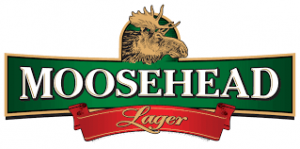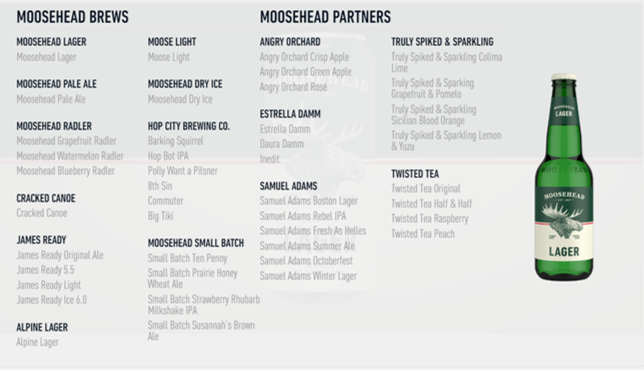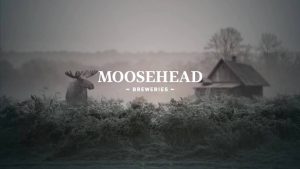35 Moosehead
Introduction
 Moosehead wasn’t always the companies name; they started out as many other breweries. Moosehead is one of the oldest family run breweries in Canada, going on six generations and established in 1867. They have a wide selection of kinds and flavours to choose from. Starting in Halifax and surviving two fires and the harbour explosion the company survived it all and is now bigger than ever.
Moosehead wasn’t always the companies name; they started out as many other breweries. Moosehead is one of the oldest family run breweries in Canada, going on six generations and established in 1867. They have a wide selection of kinds and flavours to choose from. Starting in Halifax and surviving two fires and the harbour explosion the company survived it all and is now bigger than ever.
History
 In 1867 Susannah Oland and her husband started brewing on their farm. Shortly after that she opened up a brewery called Turtle Grove Brewery and it was located in Nova Scotia. Eventually they changed the name to The Army and Navy Brewery, when her husband John Oland passed in 1870 she used inheritance money to buy out investors and changed the name yet again to S. Oland, Sons and Co. In 1878 the brewery had its first tragedy, a major fire. Susannah used the money to rebuild an even bigger brewery on the same site. In 1886 after the death of Susannah, her son George took over, but in 1895 with the coming prohibition laws he had to sell the brewery. When he sold the brewery the British syndicate renamed the family brewery, Halifax Breweries Ltd. In 1896 the brewery encountered their second fire but were able to overcome do to the new ownership and continued production.
In 1867 Susannah Oland and her husband started brewing on their farm. Shortly after that she opened up a brewery called Turtle Grove Brewery and it was located in Nova Scotia. Eventually they changed the name to The Army and Navy Brewery, when her husband John Oland passed in 1870 she used inheritance money to buy out investors and changed the name yet again to S. Oland, Sons and Co. In 1878 the brewery had its first tragedy, a major fire. Susannah used the money to rebuild an even bigger brewery on the same site. In 1886 after the death of Susannah, her son George took over, but in 1895 with the coming prohibition laws he had to sell the brewery. When he sold the brewery the British syndicate renamed the family brewery, Halifax Breweries Ltd. In 1896 the brewery encountered their second fire but were able to overcome do to the new ownership and continued production.
In 1917 they encountered the biggest tragedy of all, the Halifax harbour explosion. This killed multiple people and destroyed the brewery for the third time, so after this George put all his energy into his St. John brewery called Oland & Sons which is the site of the modern day brewery. With the money from government aid for the victims of the explosion George’s son was able to rebuild the Highland Spring Brewery as well. In 1928 Oland and sons purchased Alexander Keith’s Brewery then shortly after that George Oland purchased James Ready Brewery as well. In 1931 is when the moose finally comes into the picture for the brewery, then in 1933 they introduced Moosehead Pale Ale to the public. Finally in 1947 they changed the name of the New Brunswick Brewery to Moosehead Breweries Limited. Down below I provided an example of their original commercials showing when Moosehead came to America and how it “changed” pubs for Americans.
https://www.youtube.com/watch?v=h44uSoj5NQo
Brewing Science and Industrialization
The Oland family really didn’t start brewing until 1867 after they moved to Dartmouth. But the development of the railroad did play a big part in their brewery starting up. It helped them ship beer which started out as October Brown Ale brewed by Susannah Oland. Since the ale was so popular she gained an investor and was able to move the brewery to Halifax harbour. That was a great spot for a brewery because of all the military traffic through the area and how much beer the military consumed. (Bellamy,M,2017)
Beer Style
Moosehead originally started as a lager before eventually adopting the pale ale style of brewing. Lagers tend to have a mild alcohol, Low hop, grainy malt, low fruity-ester flavours, and have a medium finishing time. The lager is lower in malt and hops flavour, but is a golden colour, is a very carbonated beverage, also can have a crisp taste and a brilliant clarity. Pale Ales have almost no alcohol, medium hop, bready or caramel malt, citrus ester, and a short to medium finishing time. Common things to pair with lagers are a Pho type of food, ripened cheeses, or kettle corn balls. Common things to pair with Pale Ales are roasted or grilled meats, mild cheeses or apple pies. Lager styles of beer should be served in a flute style glass at 40-45°F. Ales should be served in a tulip glass at 45-55°F. Ingredients for lagers tend to include a variety of hops, 2-row and 6-row barley, and lager yeast. Ingredients for Pale Ales include centennial hops, pale or caramel malt, and an ale yeast. (Andy.sparhawk, 2018) (Cindywebdirector,2019)
The WWI & WWII Era
World War 1 had a big impact on the brewery. Not directly but it did bring on the Halifax explosion in 1917. When the SS Imo and the SS Mont-Blanc collided and exploded it killed many people and levelled many buildings including the Highland Spring Brewery which was owned by George W. C. Oland. However with help from the government they were able to rebuilt the brewery. In the prohibition the Olands mostly sold pop and 2% beer because that was still legal during that time. However they still sold “strong” beer to local pubs and shops even though it was illegal. It was that illegal act that kept the company alive. In 1933 Moosehead Pale Ale was made public and a big rivalry began, after George Sr. died in 1933 his boys parted ways and started two separate breweries. By the end of World War 2 there was the Nova Scotia Olands, they ran the Alexander Keith’s Brewery. Then there was the New Brunswick Olands, they ran the Moosehead Brewery. (Bellamy,M, 2017)
Consolidation and Globalization
 Postwar brewing for Canadians was done by the “big three”. They controlled 95 percent of the brewing in Canada. These three include: Labatt, Molson, and Canadian Breweries Limited. (Bellamy,M, 2017) Due to a tariff on certain beers from out of province, Moosehead was still able to operate with the three competitors. However Moosehead still struggled even after the prohibition because even though it was over people still weren’t able to drink publicly. This lead to the lowest rate of beer consumption ever. In 1962 the laws were about to change so Moosehead decided to release draft beer which allowed them to dominate in that market for many years.(Bellamy,M, 2017)
Postwar brewing for Canadians was done by the “big three”. They controlled 95 percent of the brewing in Canada. These three include: Labatt, Molson, and Canadian Breweries Limited. (Bellamy,M, 2017) Due to a tariff on certain beers from out of province, Moosehead was still able to operate with the three competitors. However Moosehead still struggled even after the prohibition because even though it was over people still weren’t able to drink publicly. This lead to the lowest rate of beer consumption ever. In 1962 the laws were about to change so Moosehead decided to release draft beer which allowed them to dominate in that market for many years.(Bellamy,M, 2017)
Marketing and Branding
Moosehead came up with the slogan “The Moose is Loose” once they were able to sell in the US after 3 years of trying to break into that competitive market. When they first got into the states their slogan had worked better than they thought and they sold 96,000 cases of Moosehead to Americans. Their product was mostly purchased by students in America. The best they ever did in America was six million cases in one year. After the trade barriers came down the expanded nationally.
The Modern Era
Moosehead is one of the last family owned and operated breweries. Since they are privately owned they don’t put there financial information up on the internet. However they are estimated to bring in a huge 240.4 million dollars in 2019. Moosehead has always been a big part of the community since it has been in halifax for a long time. They sponsor events and supply their beer for many events taking part in the community but also out of the community. The brewery holds tours of their brewery every day through the week at 1, 3, and 5 to show the brewing process with everyone as well as their history. The tours are offered for $17.50 for adults 19 and over and $5 for people who are 18, you just have to book them online and pay ahead of time. Moosehead partners up with habitat for humanity and builds houses. They made a large donation to start, their employees volunteer time, and the tips from their small batch brewer goes to habitat for humanity.
tours of their brewery every day through the week at 1, 3, and 5 to show the brewing process with everyone as well as their history. The tours are offered for $17.50 for adults 19 and over and $5 for people who are 18, you just have to book them online and pay ahead of time. Moosehead partners up with habitat for humanity and builds houses. They made a large donation to start, their employees volunteer time, and the tips from their small batch brewer goes to habitat for humanity.
Knowledge Checks
References
-Moosehead Breweries. (2019, August 25). Retrieved from https://en.wikipedia.org/wiki/Moosehead_Breweries.
-Moosehead Breweries: Moosehead partners with Habitat for Humanity. (n.d.). Retrieved from https://moosehead.ca/blog/moosehead-partners-with-habitat-for-humanity.
-Moosehead. (n.d.). Retrieved from https://moosehead.ca/about.
-Rezgo. (n.d.). Moosehead Brewery Tour. Retrieved from https://moosehead-tours.rezgo.com/details/125868/brewery-tour.

